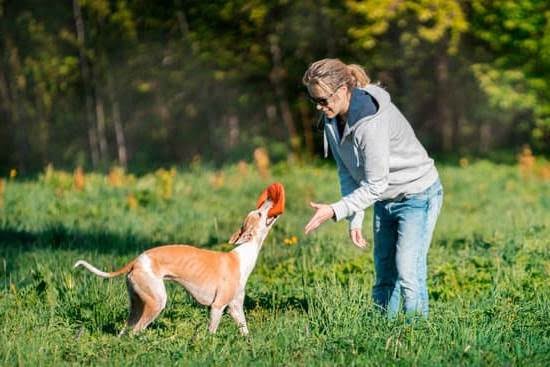Training leads are essential tools for every dog owner looking to improve their pet’s behavior and obedience. In this comprehensive guide on how to use a dog training lead, we will explore the significance of incorporating this tool into your training routine. From choosing the right type of lead to mastering different techniques, we will cover everything you need to know to effectively train your furry friend.
Using a dog training lead is crucial for teaching your canine companion proper leash manners, enhancing communication, and ensuring their safety during walks and training sessions. Whether you have a new puppy or an older dog in need of behavioral correction, a training lead can make a significant difference in their development and overall well-being.
By following the tips and techniques outlined in this guide, you will not only learn how to choose the best training lead for your pet but also discover how to use it effectively for recall training, obedience commands, and correcting unwanted behaviors. With patience, consistency, and the right tools, you can establish a strong bond with your dog based on mutual trust and respect.
Choosing the Right Type of Dog Training Lead for Your Pet
When it comes to choosing the right type of dog training lead for your pet, you must consider various factors to ensure that it is effective and safe. There are different types of leads available in the market, including long lines, retractable leads, slip leads, and traditional nylon or leather leads. The key is to select a lead that suits both your dog’s size and behavior.
For larger or more energetic dogs, a longer line may be necessary to give them more freedom while training. Retractable leads can be useful for practicing recall commands in open spaces. On the other hand, slip leads are great for quick corrections during obedience training. Nylon or leather leads are ideal for everyday walks and general training purposes.
Regardless of the type of lead you choose, it is important to ensure that it is comfortable for your dog to wear. Introduce the lead gradually by allowing your dog to wear it around the house before going outside.
This will help them get used to the sensation and weight of wearing a lead. Additionally, make sure that the lead fits properly – not too tight that it restricts movement but not too loose that your dog can easily slip out of it.
To use a dog training lead effectively, always start with short sessions in a quiet environment with minimal distractions. Use positive reinforcement techniques such as treats and praise to encourage good behavior when walking on the lead.
Gradually increase the length of your walks as your dog becomes more comfortable and responsive to your commands. Remember to be patient and consistent in your training efforts to see progress over time with using a dog training lead effectively how to use a dog training lead.
Getting Your Dog Used to Wearing a Training Lead
When it comes to training your dog, using a dog training lead is an essential tool to have. However, before you can start utilizing the lead for training purposes, it’s crucial to ensure that your furry friend is comfortable wearing it. Getting your dog used to wearing a training lead may take some patience and practice, but with the right approach, you can help them adjust smoothly.
To help your dog get accustomed to wearing a training lead, consider the following tips:
- Start by introducing the lead to your dog in a calm and positive environment.
- Allow your pet to sniff and investigate the lead before putting it on them.
- Gradually introduce the lead by letting your dog wear it for short periods inside the house.
Consistency is key when getting your dog used to wearing a training lead. By incorporating these steps into their daily routine, your pet will become more comfortable with the idea of having the lead on. Remember to always use positive reinforcement, such as treats and praise, when they cooperate with wearing the training lead.
Once your dog has adjusted to wearing the training lead indoors, you can then begin practicing with short walks outside. Be patient and provide encouragement as they get used to moving around with the lead on. With time and consistency, your furry companion will soon be ready for more structured training sessions using the lead for various commands and exercises.
Exercises for Getting Your Dog Used to Wearing a Training Lead
Here are some exercises you can do with your dog to help them get accustomed to wearing a training lead:
- Practice simple commands like sit, stay, and come while having them on a leash.
- Go on short walks in low-distraction environments to build their confidence.
- Incorporate playtime and positive reinforcement during leash-wearing sessions.
By gradually increasing their exposure to wearing a training lead through these exercises, you’ll set up a strong foundation for successful training sessions in the future. Remember that every dog is different, so be patient and adapt these exercises based on your pet’s comfort level and progress.
Understanding Proper Length and Fit for a Dog Training Lead
Properly understanding the length and fit of a dog training lead is crucial for effective training outcomes. The first step in using a dog training lead is to ensure that it is the appropriate length for your dog.
A good rule of thumb is to choose a lead that allows your dog some freedom of movement while also maintaining control. Ideally, the lead should be long enough to let your dog explore and move around comfortably, but not so long that they can easily wander off or get into trouble.
Another key aspect of using a dog training lead is ensuring that it fits your pet correctly. The lead should be snug enough to prevent your dog from slipping out of it, but not so tight that it causes discomfort or restricts their movements.
It’s essential to regularly check the fit of the lead, especially as your dog grows or if they are wearing a harness underneath. A properly fitted lead will help you maintain control during training exercises without causing any harm or discomfort to your furry friend.
When determining the appropriate length and fit for a dog training lead, consider factors such as your pet’s size, breed, and temperament. For example, larger breeds may require a longer lead to accommodate their stride, while smaller breeds may do well with a shorter lead for better control.
Additionally, dogs with high energy levels or those prone to pulling may benefit from a shorter lead to help reinforce good walking behavior. By taking these factors into account and adjusting the length and fit of the lead accordingly, you can set both you and your pet up for successful training sessions.
| Aspect | Consideration |
|---|---|
| Length | Allows freedom of movement while maintaining control |
| Fit | Snug enough to prevent slipping, but not restrictive |
| Pet Factors | Size, breed, temperament influence length and fit needs |
Techniques for Walking Your Dog Using a Training Lead
When it comes to walking your dog using a training lead, there are several techniques that can help make the experience more enjoyable for both you and your furry friend. One of the most important things to keep in mind is that consistency is key. By using the same commands and signals each time you walk your dog, they will learn what is expected of them and be more likely to follow your lead.
Start Slowly and Gradually
If your dog is new to using a training lead, it’s important to start slowly and gradually increase the distance and duration of your walks. Begin with short walks around the house or backyard, allowing your dog to get used to wearing the lead and following your cues. As they become more comfortable, you can gradually increase the length of your walks, always being mindful of their behavior and body language.
Use Positive Reinforcement
Positive reinforcement is key when walking your dog with a training lead. Whenever your dog exhibits good behavior, such as walking calmly by your side or responding to commands, be sure to praise them and offer treats or rewards. This positive feedback will help reinforce their good behavior and make them more likely to continue behaving well on future walks.
Correcting Unwanted Behavior
Inevitably, there may be times when your dog displays unwanted behavior while on a walk, such as pulling on the lead or becoming distracted by other dogs or people. In these instances, it’s important to correct their behavior calmly but firmly. Use gentle tugs on the lead or verbal cues to redirect their attention back to you. Consistency in correcting unwanted behavior will help establish boundaries and expectations for your dog while on a walk using a training lead.
Using the Lead for Recall Training and Obedience Commands
When it comes to training your dog for recall and obedience, a dog training lead can be a valuable tool. Recall training is essential for ensuring that your dog comes back to you when called, especially in potentially dangerous situations. Using a dog training lead can give you control and support during this process, helping to reinforce positive behaviors.
To use a dog training lead effectively for recall training, start by attaching the lead to your dog’s collar or harness. When practicing recall commands, such as “come” or a specific whistle sound, gently guide your dog towards you using the lead. Make sure to reward your dog with treats and praise when they respond correctly to the command while on the lead. Consistent practice and positive reinforcement will help strengthen the recall behavior over time.
In addition to recall training, a dog training lead can also aid in teaching obedience commands. Whether you are working on sit, stay, heel, or any other command, the lead can provide you with physical guidance and control to help your dog understand what is expected of them. By using consistent cues, gestures, and rewards along with the training lead, you can effectively communicate with your pet and facilitate their learning process.
| Recall Training Steps | Obedience Command Tips |
|---|---|
| Attach lead securely to collar or harness | Be patient and consistent with commands |
| Practice recall commands with gentle guidance | Use treats and praise as positive reinforcement |
| Reward correct responses with treats and praise | Provide physical guidance with the training lead |
Tips for Correcting Unwanted Behavior With a Training Lead
Identifying Unwanted Behavior
Before you can effectively correct unwanted behavior using a training lead, it is important to first identify what behaviors you want to address. Common unwanted behaviors that can be corrected with a training lead include pulling on the leash, jumping on people, barking excessively, or not responding to commands. Once you have pinpointed the specific behaviors you want to work on, you can begin implementing the appropriate training techniques.
Redirecting and Reinforcing Positive Behavior
One effective way to correct unwanted behavior with a training lead is to redirect your dog’s attention and reinforce positive behaviors. For example, if your dog starts pulling on the lead during a walk, gently but firmly redirect them back to your side and reward them when they are walking calmly beside you. This helps to communicate to your dog what behavior is expected of them and reinforces good habits.
Another important aspect of correcting unwanted behavior with a training lead is consistency. Make sure that everyone who interacts with your dog is on the same page when it comes to reinforcing proper behavior and using the training lead effectively. Consistency is key in helping your dog understand what is expected of them and will help facilitate quicker progress in their training.
Seeking Professional Assistance
In some cases, correcting unwanted behavior with a training lead may require professional help. If you find that despite your best efforts, your dog’s behavior is not improving or if the behaviors are becoming increasingly challenging to manage, consider seeking assistance from a certified dog trainer or behaviorist.
These professionals have the knowledge and experience to assess your dog’s behavior and provide customized solutions for addressing any issues using a training lead effectively. Remember that every dog is unique, so what works for one may not necessarily work for another.
Safety Precautions and Best Practices for Using a Dog Training Lead
In conclusion, using a dog training lead can be a valuable tool in helping to train and control your pet. By choosing the right type of lead for your dog’s size and behavior, getting them used to wearing it, and understanding the proper length and fit, you can set yourself up for success in training sessions.
When walking your dog with a training lead, make sure to use techniques that encourage good behavior such as loose leash walking. Additionally, utilizing the lead for recall training and obedience commands can help reinforce positive behaviors and build a strong bond between you and your furry friend.
Lastly, remember to always practice safety precautions when using a dog training lead. This includes proper supervision, avoiding leaving the lead on when unattended, and being aware of potential hazards in your surroundings. By following these best practices, you can ensure a safe and effective training experience for both you and your beloved pet.
Frequently Asked Questions
How Do I Use a Training Lead?
Using a training lead involves attaching it to your dog’s collar or harness to provide better control during walks or training sessions. It allows you to guide your dog without giving them the full freedom of a regular leash.
How Do You Use a Training Leash?
When using a training leash, it is important to start with short sessions to help your dog get accustomed to the feeling of being guided. Use gentle movements to direct your dog’s behavior and always reward positive responses.
Are Training Leads Good for Dogs?
Training leads can be beneficial for dogs who need extra guidance, whether they are learning basic commands or struggling with behavioral issues like pulling on the leash. They provide a way to communicate clearly with your dog and can improve their walking manners over time.

Welcome to the blog! I am a professional dog trainer and have been working with dogs for many years. In this blog, I will be discussing various topics related to dog training, including tips, tricks, and advice. I hope you find this information helpful and informative. Thanks for reading!





